How Much Does It Cost to Install a Vinyl Fence?
Whether installing a brand new fence at a new home or replacing an old fence, vinyl fencing is a great option. This material provides privacy, enhances curb appeal, and requires little maintenance. Many color and design options are available, so it is easy to get the look you want.
The cost of installing vinyl fencing varies depending on the yard size, material costs, and the extent of prep work. The average cost to install a vinyl fence ranges from $4,000 to $7,300, with the average homeowner spending around $5,800 for 209 linear feet of white vinyl privacy fence surrounding a ¼-acre yard. This project’s low cost is $3,000 for a 209 ft. 3-foot tall vinyl picket fence around a ¼-acre yard. The high cost is $16,000 for a 418 ft. 6-foot tall black vinyl privacy fence enclosing a ½-acre yard.
Vinyl Fence Installation Cost
| Vinyl Fence Prices | |
|---|---|
| National average cost | $5,800 |
| Average range | $4,000-$7,300 |
| Low-end | $3,000 |
| High-end | $16,000 |
In this guide
Vinyl Fence Cost per Acre
Vinyl Fence Cost Per Foot
Vinyl Fence Cost per Panel
PVC Fence Cost by Type
Vinyl Fence Pricing by Style
Labor Cost to Install a Vinyl Fence
Vinyl Fence Gate Cost by Type of Gate
Vinyl Fence Gate Cost by Type of Fence
Vinyl Fence Wind Resistance
Pros and Cons
How to Clean a Vinyl Fence
PVC vs Vinyl Fence
Enhancement and Improvement Costs
Additional Considerations
FAQs
Vinyl Fence Installation Cost by Project Range
Vinyl Fence Cost per Linear Foot
Vinyl 1 fencing costs between $10 and $30 a square foot for the material and between $15 and $40 a linear foot installed. Like all fences, PVC fences are installed by the foot or length of the installation. The larger the run of fencing you need, the higher the costs.
Your fence installation can be any length, but the average is around 209 linear feet or a ¼ acre. However, you can use PVC fencing on yards of any size, from a short decorative run of fencing across the front of your property to enclosing one or more acres of land. Below are the average costs to install vinyl fencing on several yard sizes of up to a ½ acre.

| Size | Cost (Installed) |
|---|---|
| 50 Linear Feet (Small Front Yard and Sides of the Home) | $750 - $2,000 |
| 100 Linear Feet (Small Front Yard and Sides of Home) | $1,500 - $4,000 |
| 150 Linear Feet (Small Yard) | $2,250 - $6,000 |
| 200 Linear Feet (Small Yard) | $3,000 - $8,000 |
| 300 Linear Feet (Medium Yard) | $4,500 - $12,000 |
| 420 Linear Feet (½ Acre) | $6,300 - $16,800 |
Vinyl Fence Cost per Acre
Vinyl fencing is not the most affordable fencing material on the market, but it is durable and attractive. Some enclose a larger property in vinyl, but homeowners with multiple acres may want to use something more affordable or something designed for livestock. While PVC is attractive, it is not the best choice for livestock or security on a large property. However, you can enclose one or two acres with vinyl to create a more decorative border. The average cost to install fencing in an acre of property with vinyl is $12,540 to $33,440.
Vinyl Fence Cost Per Foot
The height of your fencing also increases costs. Vinyl fencing comes in several heights, from a 3-foot picket fence 2 to 12-feet for privacy fences 3. The average vinyl fence is around 6-feet tall and costs $15 to $40 a linear foot.
Choosing a fence’s height depends on the yard that it will be surrounding and the buyer’s goals for the fence. However, it is important to note that taller fencing is generally more expensive than their shorter counterpart, but this is not always the case. In some instances, shorter, more decorative fencing can be more expensive than taller plain-looking fencing. Each size has a range of costs, and there can be a lot of overlap.
Some specific types, such as pool fences, must meet a minimum height by law (4 feet). However, most heights are at the discretion of the owner and their personal preference. In some cases, the style impacts its height. Most picket fencing is between 3 and 4 feet in height, while privacy fencing starts at 6 feet. If you have a pool you want to create privacy for, you may want to go even taller if you have close neighbors. The table below lists the average prices for PVC fencing, ranging from 4 to 12 feet tall.

| Height | Average Price (Installed) |
|---|---|
| 4 Feet | $15 - $25 |
| 6 Feet | $15 - $40 |
| 8 Feet | $30 - $45 |
| 10 Feet | $35 - $50 |
| 12 Feet | $40 - $60 |
Vinyl Fence Cost per Panel
While vinyl fences are usually installed by the linear foot, they are often sold by the panel. A panel is a single section of fencing usually 6 or 8 feet in length. Generally, smaller panels are around 6 feet, and taller panels are around 8 feet in length.
The price of a PVC fence panel varies depending on several factors, including the panel height, length, style, and color. Panel costs range between $70 for a basic white privacy panel up to $500 for a designer black vinyl panel.
If you are installing the fence yourself or purchasing it from someone other than your installer, you need to calculate the number of panels to complete your installation so that you order correctly. Your installer can help with this. You can cut and adjust the panels on-site, so round up the number of panels if a partial panel is necessary. For example, if your measurements call for 15.5 panels, purchase 16 panels.
Below are the average number of panels you need per installation for some of the most common lengths. Panels have been rounded up to the nearest full panel. Keep in mind that if you choose 6-foot panels, you need more to complete the installation than 8-foot panels.

| Size | Number of 6-Foot Panels Needed | Number of 8-Foot Panels Needed |
|---|---|---|
| 100 Linear Feet | 17 Panels | 13 Panels |
| 200 Linear Feet | 34 Panels | 25 Panels |
| 300 Linear Feet | 50 Panels | 38 Panels |
| 400 Linear Feet | 67 Panels | 50 Panels |
| 500 Linear Feet | 84 Panels | 64 Panels |
PVC Fence Cost by Type
Many types of vinyl fencing are available. Choose from basic, affordable options, like split rail or lattice fencing, or go for a more high-end look, such as shadowbox fencing. There are many ways to customize and get the look that you desire for your yard. Both desired appearance and intended functionality determine which type of PVC fencing best suits a homeowner’s needs. The following table and subsections provide detailed information about each of these variations and their pricing per linear foot or panel. The prices below do not include installation prices. Take a look to find out which fencing option best suits your needs.

| Type | Cost per Linear Foot (Materials Only) | Cost per Linear Foot (Installed) |
|---|---|---|
| Split Rail | $6 - $8 | $11 - $18 |
| Picket | $10 - $25 | $15 - $35 |
| Privacy | $10 - $30 | $15 - $40 |
| Lattice | $13 - $35 | $18 - $45 |
| Shadowbox | $13 - $35 | $18 - $45 |
Vinyl Split Rail Fence Cost
The average vinyl horse fence cost is between $6 and $8 per linear foot for material or between $11 and $18 a linear foot installed. Vinyl split rail fencing 4, also known as a ranch rail vinyl or horse fence, is a low-cost fencing solution for enclosures of all sizes. They are also commonly referred to as post and rail fencing. This fencing gets its name because it is frequently used as a visual and physical barrier for farm animals like horses, donkeys, and cows.
The fencing can have between two and four rails, depending on what you want the fence for. Many people who want a decorative border fence opt for a two rail fence, while those who want to keep in livestock should opt for a fence with more rails. The rails are aligned between vertical posts spaced roughly 6 feet apart. The height varies depending on the number of rails but typically ranges from 3 to 5 feet. The following table offers pricing for different split rail fences per linear foot, depending on the number of rails.

| Number of Rails | Average Price per Linear Foot (Materials Only) | Average Cost per Linear Foot (Installed) |
|---|---|---|
| Two Rails | $6 - $7 | $11 - $17 |
| Three Rails | $6 - $8 | $11 - $18 |
| Four Rails | $7 - $8 | $12 - $18 |
Vinyl Picket Fence Cost
The average price of vinyl picket fencing is $10 to $25 per linear foot for material or $15 to $35 a linear foot installed. Vinyl picket fences are a terrific option for residential enclosures, large or small. Some of the biggest advantages of installing this type of fencing are the ability to maintain visibility and establish a safe, solid boundary for animals and/or children. They very common for front yards. They are generally shorter and do not offer privacy.
Vinyl Privacy Fence Cost
The average price of a vinyl privacy fence is around $10 to $30 per linear foot for material or $15 to $40 a linear foot installed. Unlike picket fencing, privacy fencing is ideal for limiting visibility in a residential space. Many vinyl privacy fences are assembled using the tongue and groove method, consisting of interlocking pickets that create a solid seamless surface. They are most common with a top rail style with PVC but you can also find dog ear and stockade-style fences.
Vinyl Lattice Fence
The average cost of vinyl lattice fencing is around $13 to $35 per linear foot for material or $18 to $45 a linear foot installed. They are less common than other fencing types. They are most often used in gardens and other decorative areas rather than for an entire property. They are an economical choice for home or landowners who like to include a slightly see-through barrier on their property. They offer outstanding durability and a lasting like-new appearance. Buyers do not have to worry about rotting, cracking, or splintering with reliable vinyl lattice fences.
Vinyl Shadowbox Fence
The average price of a vinyl shadowbox fence falls between $13 and $35 per linear foot for material or $18 to $45 a linear foot installed. They are a fantastic choice for buyers who want to invest in a long-lasting, attractive enclosure for their home. They simultaneously allow for enjoyable air flow, light filtering, and significant privacy. They are easy to maintain, and buyers have a range of available options from economical to luxurious.
Vinyl Fence Pricing by Style
When it comes to sprucing up a vinyl fence, homeowners have numerous options at their disposal. Some of the most common ways to customize a vinyl fence are to opt for wood grain, colored, a decorative lattice top, or unique PVC panels. Look at the following table for average price ranges for some of the most common beautification methods for PVC fencing. The figures in this table are based on a vinyl fence that is 6 feet tall, with prices noted per linear foot of material.

| Style | Average Price per Linear Foot (Materials Only) | Average Price per Linear Foot (Installed) |
|---|---|---|
| Decorative PVC Panels | $6 - $15 | $11 - $25 |
| Colored | $10 - $30 | $15 - $40 |
| Lattice Top | $13 - $35 | $18 - $45 |
| Wood Grain Fencing | $15 - $35 | $20 - $45 |
Decorative PVC Fence Panels
The average price of decorative PVC fencing is between $6 and $15 per linear foot for materials. Installed, this material costs $11 to $25 a linear foot. This is the most economical choice for enhancing your vinyl fencing. PVC refers to the plastic polymer used to create vinyl fencing, polyvinyl chloride. Aside from its generally low price, one of the biggest advantages of using decorative PVC fencing is the various options available. Homeowners can find this fencing in a range of creative designs to distinguish their fence’s appearance. Decorative PVC fencing becomes increasingly expensive as the panel length increases. Many lengths are available for decorative vinyl panels that can accommodate small and large enclosures.
Colored Vinyl Fence
It costs $10 to $30 per linear foot for colored vinyl fencing material. Installed, this style costs $15 to $40 a linear foot. In general, the darker or more saturated the color, the higher the costs. Colored vinyl fencing is a fantastic way for homeowners to give their home enclosure a personal touch and complement the exterior aspects of their residence. Some of the most popular colored PVC fencing colors are brown, gray, and sand-colored. Black is also available for a more chic look. This is the most expensive option at $55 to $65 per linear foot installed.
Vinyl Fence Lattice Top
The average price of a linear foot of vinyl fence lattice top is $13 to $35 for the material. The cost of this style installed is $18 to $45 a linear foot. Because most vinyl fencing with a lattice top is solid, it provides many of the benefits that privacy fencing delivers. Depending on the height, neighbors and passersby cannot see into the enclosure. Additionally, homeowners can enjoy the stylish design that comes with lattice-topped fencing. Various unique lattice designs are available for these fences, large and small.
Wood Grain Vinyl Fence Cost
Wood grain vinyl fencing costs $15 to $35 per linear foot for materials. The average cost of this style installed is $20 to $45 a linear foot. Wood grain fencing can create a natural atmosphere that complements its surroundings. By opting for PVC over pure wood, homeowners can enjoy the durability of vinyl. With materials that last for years, homeowners do not need to worry about cleaning, maintenance, rot, or excessive moisture. Wood grain comes in many colors, with only texture to set it apart from traditional PVC fencing.
Labor Cost to Install a Vinyl Fence
The cost to install vinyl fencing ranges from $5 to $10 a linear foot. Some installers quote labor by the hour for very large projects, at a cost of $30 to $60 an hour. Costs vary depending on several factors, including the panel height and the area you install the panels on.
If your ground is hard, stony, or difficult to dig in, your installer charges closer to $10 a linear foot for the project. Your costs are also on the higher end if your ground is uneven. Level yards that are easy to work in cost less in labor for the same fencing installation.
The time it takes to install your fence ranges depending on these factors and the length. Small fences can be done in a few hours, while fencing in a half-acre may take a few days with the curing of the concrete to set the posts. When removing old fencing before installation, this increases costs and the length of the project.
Below are the average labor costs for installing fencing in yards of varying sizes.

| Size | Average Labor Costs |
|---|---|
| 50 Linear Feet | $250 - $500 |
| 100 Linear Feet | $500 - $1,000 |
| 150 Linear Feet | $750 - $1,500 |
| 200 Linear Feet | $1,000 - $2,000 |
| 300 Linear Feet | $1,500 - $3,000 |
| 420 Linear Feet (½ Acre) | $2,100 - $4,200 |
Vinyl Fence Gate Cost by Type of Gate
While not every fence installation includes a gate, many do. Gates allow access to the yard from the road or sidewalk or allow you out of the yard and onto the rest of a larger property. Vinyl gates come in many sizes and styles, which can match the fence you are installing.
The average price to install a gate into a vinyl fence falls between $200 and $2,200, depending on the size and style. Swing gates are the most common. They open into the yard or swing outward, depending on the layout. If you have a larger opening, consider a double or double swinging gate. This can also be a choice for driveways.
Other choices include sliding gates, which move laterally across the opening, and automatic gates. Automatic gates are most commonly used with driveways, and they can swing or slide, depending on the style. If you want a gate installed in your new PVC fence, it must be included in the original design. This is because posts must be set that can fit the gate. The additional cost to add a gate varies depending on the gate size, quality, and details.

| Type of Gate | Average Price (Installed) |
|---|---|
| Swing | $200 - $1,100 |
| Sliding | $200 - $1,200 |
| Double | $500 - $2,000 |
| Automatic | $750 - $5,600 |
Vinyl Fence Gate Cost by Type of Fence
The average cost of vinyl fence gate installation is between $200 and $2,100, depending on the fence type the gate is being installed in. PVC gates are usually designed to match the fence style they are installed in. For example, if you have a picket fence, you should use a picket gate.
In most cases, homeowners install a swinging gate in their vinyl fencing. However, you can also install a range of other types, depending on whether this is a driveway or walkway gate and how it is used. Homeowners should note the price increases if it is in a color other than white.

| Type of Fence (to Install the Gate Into) | Average Cost of the Gate (Installed) |
|---|---|
| Privacy | $200 - $1,000 |
| Split Rail | $200 - $1,100 |
| Picket | $260 - $1,200 |
| Lattice | $350 - $2,000 |
| Shadowbox | $400 - $2,500 |
Vinyl Fence Wind Resistance
If you live in an area with high winds, ensure the fence you purchase can stand up to the winds no matter how hard they blow. They are generally fairly durable and hold up well to all kinds of inclement weather.
Provided they are installed properly, PVC fencing can withstand winds up to 100 mph. To ensure your fencing is wind resistant, invest in posts between 3.5 and 5-inches square with a wall thickness of a minimum of 0.160 inches.
For larger privacy fencing, the posts should be at least 5-inches square with a wall thickness of 0.130 to 0.270 inches. These posts should extend a minimum of 1.5 to 2 feet into the ground and be set with concrete for added durability. If your fencing supports them, consider adding post caps 5 to enhance your fence’s wind resistance.

Pros and Cons
As with all fencing types, there are pros and cons of vinyl fencing. PVC fencing can last between 10 to 20 years when installed properly. And, in many instances, the material can be recycled after it reaches the end of its life.
The cost of a new vinyl fence is comparable to other fencing types and maybe less expensive. Vinyl is also much easier to maintain. It does not require sanding 6 or paint and is not affected by moisture. PVC also resists issues that can impact other fences, such as rotting, blistering, fungus growth, insects, and flame. Vinyl is also fairly easy to install.
Vinyl can be more expensive than some materials, with a slightly higher installation cost. The fencing requires concrete footers 7, which must be planned for ahead of time. In addition, vinyl does not do well in extreme temperatures. It can melt or warp in high heat or become brittle in very cold weather. Any impacts that hit the fence during cold weather could create cracks or holes in it. In addition, it can be more difficult to repair than other types if the fencing becomes damaged.
How to Clean a Vinyl Fence
Vinyl fencing is fairly low-maintenance, not requiring sanding, scraping, or painting. However, it needs periodic cleaning because dirt, algae, and other debris can build on the surface. Vinyl with a wood texture can also hold more debris and dirt than PVC with a smooth surface.
To prevent dirt issues, you can rinse it weekly with a garden hose. This helps remove the surface dirt without much effort. For more stubborn dirt, use a soft bristled brush with the hose to wipe away grime in the texture.
If the fence has built up a lot of dirt or algae, use a pressure washer on a low setting to help remove the build up. Test this on an inconspicuous area first to ensure it does not damage the fence.

PVC vs Vinyl Fence
PVC stands for polyvinyl chloride, which is the term that “vinyl” comes from. So, PVC and vinyl fences are technically the same. Part of this is branding. Some manufacturers refer to their fences as vinyl, while others refer to theirs as PVC, but they are essentially the same.
Regardless of what they are called, there are different variations of the formula used to create these fences. They may contain different additives, which can make them stronger and more durable or weaker and more prone to cracks. If you are concerned about a specific attribute, speak to the manufacturer about available additives or options.
Enhancement and Improvement Costs
Fence Additives
Some brands offer additives for their fencing to enhance its appearance or durability. These can include UV inhibitors to prevent fading and impact modifiers to make the material stronger. If you live in an area with extreme temperatures, you may want to invest in stabilizers, which can keep the composition consistent even with temperature changes. Adding an additive to the fence costs an additional $1 to $3 a linear foot.
Ornamental Vinyl Fencing
Ornamental or decorative vinyl fencing adds curb appeal to your home. In addition to lattice tops, you can also find decorative options like finials 8 or spikes that make your fence look like wrought iron. Ornamental vinyl fencing adds between $2 and $5 per linear foot.
Vinyl Fence Post Inserts
Vinyl fence post 9 inserts can be placed inside the posts to make them stronger. The average price range for an individual post insert is between $40 and $95. Post inserts are available in various materials, from steel and aluminum to wood, with steel costing the most and wood the least.
Removing Old Fencing
If you have an existing fence, you need to remove and dispose of it before you can install the new fence. This costs $2 to $5 a linear foot, depending on the old fence’s material. This can also add a few days to the project timeline.
Additional Considerations and Costs
- Permits and licenses. Depending on the area you live in, you may need a permit to install a fence. The cost of the permit varies depending on the town and fence height. Speak to your municipality for more information.
- DIY. Vinyl fence kits are available to make installation easier. However, it is generally a good idea to get professional installation. A professional has the proper equipment and knowledge to get the job done quickly and correctly. A solid installation is key to ensuring your PVC fence lasts a long time.
- Fence decor. You can dress your fence with landscaping, lattice, and decorative items to improve your property’s curb appeal.
FAQs
- How much does vinyl fencing cost installed?
This varies depending on the fence height and quality and the size of the enclosed area. The average cost of a vinyl fence ranges from $4,000 to $7,300.
- How much wind can a privacy fence withstand?
Vinyl privacy fences can withstand up to 100 mph winds with the proper installation, including posts inserted into concrete footings that reach 1.5 to 2 feet underground and ensuring the material is thick enough. If you need a high-wind fence, speak to your installer to make sure it is properly installed.
- How long does it take to install a vinyl fence?
This depends on several factors. If you need concrete footings, expect it to take at least a few days. If not, some small fences can be installed in a few hours.
- Do vinyl fences need wood posts?
No, you can use vinyl posts with your fence. You can also mix materials or choose vinyl posts with a wood or metal interior for strength.
- How far off the ground should a vinyl fence be?
A vinyl fence should sit between 2 and 5 inches off the ground. Some variation is sometimes needed to allow for terrain variations.
- Do you need a permit to put up a privacy fence?
This depends on where you live. You need a permit in most areas, but check with your local municipality to find out more.
Remodeling Terms Cheat Sheet
Definitions in laymen's terms, cost considerations, pictures and things you need to know.See full cheat sheet.
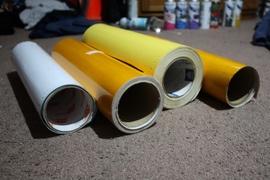 1 Vinyl: A synthetic plastic made from ethylene and chlorine. Vinyl has many applications in the construction industry and it is widely used in sidings, window frames, roofing and gutters, among others
1 Vinyl: A synthetic plastic made from ethylene and chlorine. Vinyl has many applications in the construction industry and it is widely used in sidings, window frames, roofing and gutters, among others
 3 Privacy fences: A barrier or railing, typically composed of solid material, used to form a blockade around a yard, field, or other expanse of land to prevent encroachments from the outside
3 Privacy fences: A barrier or railing, typically composed of solid material, used to form a blockade around a yard, field, or other expanse of land to prevent encroachments from the outside
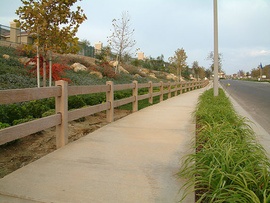 4 Split rail fencing: A barrier or railing, often associated with ranches and farms, typically made of wood (or vinyl) and composed of posts and a varying number of horizontal rails
4 Split rail fencing: A barrier or railing, often associated with ranches and farms, typically made of wood (or vinyl) and composed of posts and a varying number of horizontal rails
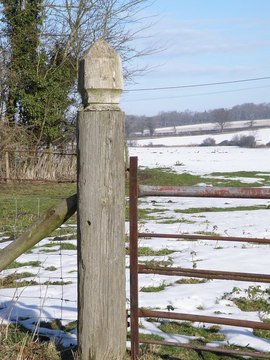 5 Post caps: An optional fence design detail, positioned on top of each fence post, used to give the fence a "finished" look and to prevent water from entering the posts
5 Post caps: An optional fence design detail, positioned on top of each fence post, used to give the fence a "finished" look and to prevent water from entering the posts
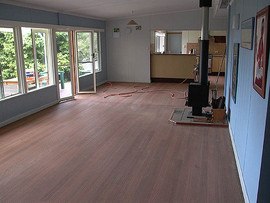 6 Sanding: Process of removing the top surface of a material, such as wood, using sandpaper and/or a specialized sanding machine (for large surface areas)
6 Sanding: Process of removing the top surface of a material, such as wood, using sandpaper and/or a specialized sanding machine (for large surface areas)
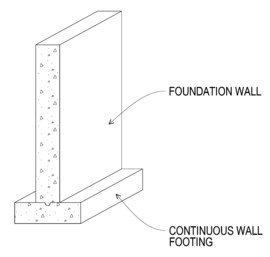 7 Footers: A support for the foundation of a house that also helps prevent settling. It is typically made of concrete reinforced with rebar, but can also be made of masonry or brick. It is usually built under a heavier part of the house like a wall or column, to distribute the weight of the house over a larger area.
7 Footers: A support for the foundation of a house that also helps prevent settling. It is typically made of concrete reinforced with rebar, but can also be made of masonry or brick. It is usually built under a heavier part of the house like a wall or column, to distribute the weight of the house over a larger area.
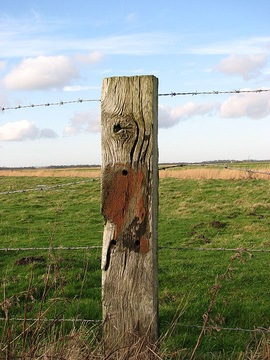 9 Fence post: A sturdy pole set securely in the ground, that is used to support a fence. Fence posts are placed at regular intervals, and the other parts of the fence are attached to them
9 Fence post: A sturdy pole set securely in the ground, that is used to support a fence. Fence posts are placed at regular intervals, and the other parts of the fence are attached to them
How much does it cost to install a vinyl fence in my city?
Cost to install a vinyl fence varies greatly by region (and even by zip code). To get free estimates from local contractors, please indicate yours.










